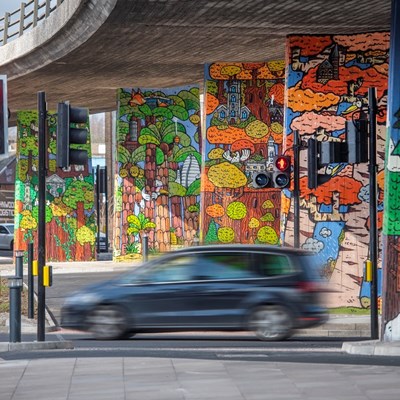AIR pollution in Leicester was at its lowest level ever recorded last year, as the city saw a huge reduction in traffic as result of the coronavirus lockdown.
The latest annual figures – collected from a network of air quality monitoring stations at five key locations across the city in 2020 – show that Leicester is meeting all current EU air quality objectives, including for nitrogen dioxide (NO2) for the first time since monitoring began over 20 years ago.
European and national guidelines set an annual mean limit value of 40micrograms per cubic metre (µg/m3) for nitrogen dioxide in the air.
Average levels of NO2 improved significantly at all five monitoring locations last year and represent a reduction of around 60 per cent since 2010, when the highest levels – of up to 80 µg/m3 – were recorded.
At Vaughan Way – one of the city’s busiest roads and an air quality hot spot – average NO2 levels for 2020 were 35.2µg/m3 compared to 45.7µg/m3 in 2019.
At Abbey Lane, annual levels have fallen from 31.4µg/m3 in 2019 to 24.3µg/m3 in 2020, the lowest recorded level from any of the city’s five monitoring stations.
At Glenhills Way, NO2 levels were down from 48.6µg/m3 in 2019 to 38.8µg/m3 in 2020; Melton Road saw a drop from 38.5µg/m3 in 2019 to 28µg/m3 last year; and, at St Matthew’s Way, a reduction from 40.6µg/m3 to 31.4µg/m3 was recorded.
Deputy City Mayor Cllr Adam Clarke, who leads on environment and transportation, said: “While this dramatic improvement in air quality is good news for the city, we have to put into the context of drastically reduced traffic levels as people followed the rules and stayed at home during the lockdown.
“Nevertheless, having clean and fresh air to breath in the city couldn’t be more important as we continue to face the threat of potentially severe respiratory illness caused by coronavirus.
“While we can’t expect pollution level to remain this low as we recover from the impact of the pandemic and life eventually returns to normal, we are doubling down on efforts to remain below EU limits and continue the huge improvements we have seen in recent years.
“We will also continue encouraging people to make the shift to sustainable transport as part of our response to the climate emergency. We are investing over £80million to fund major improvements to local public transport and support more cycling and walking routes into city neighbourhoods and the city centre, all backed the Government’s Transforming Cities Fund. This will help ensure that we can make long term improvements to air quality and achieve our aim of healthier air for Leicester.”
Figures from automatic counters in the city indicate that traffic levels fell by over 22 per cent over a nine-month period from March 2020, when lockdown began, compared to the same period in 2019 – a drop of almost two million vehicles.
However, Leicester had already seen massive improvements in air quality in recent years. The annual averages for levels of NO2 in 2019 were the lowest ever recorded until last year, with levels recorded at four of the five monitoring stations below European and national guidelines.
Leicester was already compliant with national guidelines for all other currently stated pollutants. These include benzene, 1,3-butadiene, carbon monoxide, lead, sulphur dioxide, PM 10 particulates and PM2.5 particulates.
Current national guidelines set a maximum annual average for PM2.5 at 25μg/m3. There are no limits sets established for daily or hourly levels. The World Health Organisation recommends that annual average levels of PM2.5 should not exceed of 10μg/m3.
Leicester’s most recently recorded annual average for PM2.5 was below 11μg/m3.
Cllr Clarke added: “While we are currently directed to reduce air pollution to within EU limits, we are already focussed on meeting the more ambitious guidelines recommended by the World Health Organisation and our ultimate aim is to go beyond those limits too.”
Leicester’s annual air quality figures for 2020 were ratified by experts at University College London as required by the Department for Environment, Food and Rural Affairs (Defra).
